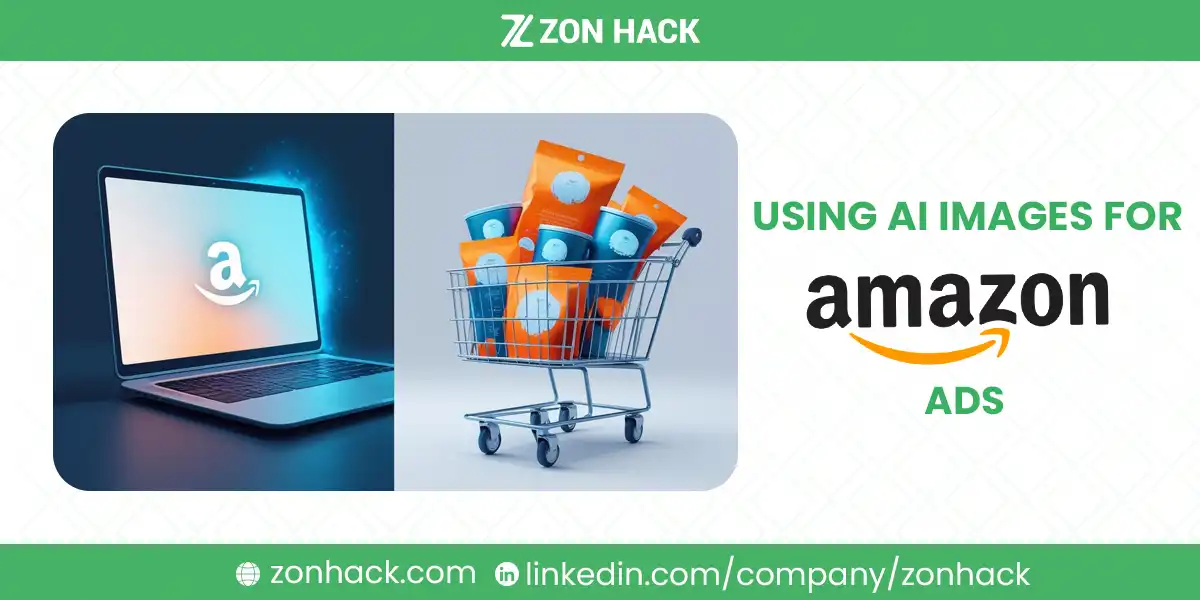On Amazon, your product image is your first impression—often the only chance you get to stop a scroll and spark a click.
That’s why visual content isn’t just a nice-to-have. It’s one of the most critical drivers of click-through rate (CTR), conversion rate, and ultimately, your return on ad spend (RoAS). And in the race to capture shopper attention, AI-generated imagery is becoming a powerful secret weapon.
In recent months, Amazon has quietly rolled out AI-powered image generation tools, allowing sellers and advertisers to produce studio-style visuals and lifestyle content using just a prompt.
This shift isn’t happening in a vacuum. Generative AI and computer vision are now transforming the broader digital advertising ecosystem. Amazon is simply adapting fast, and smart advertisers are moving with it.
At ZonHack, where we manage high-performance Amazon ad systems for 6–8 figure brands, we’ve started integrating AI imagery into our creative testing workflows, not as a gimmick, but as a practical, scalable tool to launch faster, test smarter, and optimize harder.
Let’s break down what this means for you.
What Is AI Image Generation and How Amazon Uses It
AI image generation involves the use of machine learning models, like diffusion or GANs (Generative Adversarial Networks), to create images from text inputs or data prompts. You describe a scene or setting, and the AI generates a visual that matches.
Amazon’s Image Generator brings this power straight into the Ads Console and DSP—no third-party tool or expensive photo shoot required.
You simply select a product, describe a desired scene (like “cozy holiday kitchen with soft lighting”), and the tool generates images around that concept. The AI takes into account the product category, season, setting, and layout to create variations suitable for ad placements.
Here’s what’s customizable:
- Scene types: kitchen, bathroom, outdoor, etc.
- Thematic backgrounds: holidays, seasons, moods
- Aspect ratios: horizontal, vertical, square—ready for Sponsored Brands, Sponsored Display, or even your Amazon Store
Amazon’s AI image generation is currently available in the US, Canada, UK, EU, India, and Australia. And yes—it’s free inside your Amazon Ads dashboard.
Why AI-Generated Images Matter for Amazon Ads
So why even consider using AI images when traditional photography exists?
Let’s walk through the value:
Faster Content Creation
Traditionally, launching a new creative means planning a shoot, hiring a team, editing images—and waiting weeks. AI flips this timeline. With AI, you can go from idea to image in minutes.
This means faster A/B tests, quicker campaign refreshes, and more reactive ad cycles—especially useful during promos, seasonal launches, or trend shifts.
Lower Creative Costs
Hiring a photographer or agency often costs hundreds to thousands per shoot. Add in model fees, location rentals, props, and post-editing, and the numbers quickly escalate.
With AI, those costs disappear. You can slash your creative budget by up to 70–80%, especially for supplementary assets.
“We’ve seen clients reduce lifestyle image production costs from $1,200 to under $100 per ASIN using AI workflows.” – ZonHack Media Team
More Variety = Better Performance
With AI, you can generate dozens of variations: different scenes, backgrounds, tones, angles. This gives you creative fuel for testing.
We’ve found that brands using AI creatives for Sponsored Display and Sponsored Brands saw up to 28% higher CTR when running variant tests vs. using the same old static images.
On-Brand Flexibility
AI doesn’t mean generic. You can prompt the generator to reflect your brand voice, whether it’s minimalist, rustic, bold, or premium.
Just guide the scene: “Scandinavian-style living room with neutral tones,” or “colorful outdoor picnic with tropical elements.” You’re not stuck with Amazon’s defaults.
Optimized for Testing & Iteration
Because AI output is nearly instant, you can rapidly test which visuals increase RoAS and reduce ACoS—without re-shooting.
Want to test a “holiday kitchen” scene versus a “sunlit summer patio” look? Generate both. Track what converts better. This supports data-backed creative decisions, not just design gut feelings.
A ZonHack Note on Strategic Use
While AI-generated images are fast and cost-effective, they’re not a silver bullet.
At ZonHack, we don’t treat them as shortcuts—but as strategic tools to augment human creativity, not replace it. We use AI assets within broader ad funnels, keyword targeting systems, and campaign architectures designed to scale profitably.
AI helps accelerate the creative leg—but it’s our full-funnel performance systems that drive results.
How to Use Amazon’s AI Image Generator: Step-by-Step
If you’re ready to try Amazon’s built-in image generator, here’s how it works.
Accessing the Tool
Go to your Amazon Ads Console, then navigate to:
Creative Tools → Image Generator
Or, inside DSP, use the REC (Responsive eCommerce Creative) module.
Step-by-Step Process
- Select a product by ASIN or product title.
- Enter a prompt describing the desired scene, like “sunlit living room with soft textures” or “holiday dining setup with warm lighting.”
- Choose scene styles, including lifestyle, abstract, or plain backgrounds.
- Add seasonal elements or thematic tones if needed.
- Click Generate.
- Preview the image sets Amazon provides.
- Edit, crop, or adjust the visuals with built-in tools.
- Save to your Creative Assets library or apply directly to an ad.
You can generate for horizontal (16:9), vertical (9:16), and square (1:1) formats—so the same prompt can power Sponsored Brands, Sponsored Display, and Storefront creative.
Writing Better Prompts: Get the Most Out of AI Imagery
Here’s the truth: your prompt quality determines your image quality.
Most bad outputs come from vague or poorly framed prompts. Want better images? Start with better descriptions.
Smart Prompting Tips
- Be Specific: “A clean white marble kitchen with natural morning light” will outperform “kitchen.”
- Skip commands: Don’t say “add a window” or “center the product.” Focus on describing, not instructing.
- Include mood, texture, and context: Mention the ambiance—warm, cozy, minimalist, bold.
- Frame the product as the star: Describe its setting, but emphasize its prominence.
Bonus: Advanced Prompting Enhancements
If you want to level up even further, consider adding:
- Photo styles: DSLR quality, shallow depth of field
- Lighting cues: natural daylight, soft shadows, studio spotlight
- Art direction: top-down angle, side-lit, high contrast, neutral tones
These additions give Amazon’s AI clearer instructions to deliver visuals that align with your brand’s tone.
Potential Risks, Drawbacks & Legal Considerations
AI-generated visuals promise speed and flexibility—but they aren’t risk-free. Brands need to tread carefully, especially when operating at scale or within strict compliance categories like health, beauty, or electronics.
The Visual Accuracy Problem
One of the most common pitfalls is misrepresentation. AI images can render a product in a scene that looks polished, but not accurate.
For example, a 2-inch bottle cap might appear the size of a coffee mug. Materials like stainless steel may come out looking like plastic. These small inconsistencies can have big implications—especially if the customer feels misled.
Customer trust is fragile. A beautiful but unrealistic visual can lead to returns, bad reviews, or worse—an account suspension if Amazon’s policies are breached.
Overuse and Generic Templates
As more sellers adopt AI, a new problem emerges: sameness.
Too many listings start to look like they were built with the same prompts and same tool. The uniqueness of your brand gets lost in a sea of templated AI backgrounds and lifestyle scenes.
At ZonHack, we’ve seen this in multiple categories—especially supplements and home decor—where dozens of ads carry nearly identical beach or kitchen backdrops. It lowers perceived value and makes it harder to stand out.
Brand Misalignment
AI doesn’t “understand” your brand values—it just assembles pixels based on a prompt. Without human oversight, the resulting image might clash with your intended identity.
A minimal, clean skincare brand could end up with a cluttered, over-saturated bathroom setting. A premium leather product might appear in a background that screams discount store.
ZonHack always recommends layering human QA into the process. Don’t treat AI as a final solution—treat it as a starting point.
Legal and Compliance Concerns
Legal grey areas are still unfolding in the world of generative AI. While Amazon provides the Image Generator for advertiser use, you’re still responsible for:
- Ensuring no trademarked content appears in the background
- Verifying that your product’s function and claims are not misrepresented
- Meeting Amazon’s advertising policies, which prohibit misleading visuals
This is especially important in categories like health & wellness, cosmetics, electronics, or baby products.
ZonHack helps brands build internal SOPs to manage these legal filters at scale. We also recommend using prompt logs to trace and justify the creative process, in case issues arise later.
AI Images vs. Traditional Product Photography
Let’s get tactical.
Here’s how AI-generated images compare to traditional photography across key dimensions:
| Criteria | AI Image Generation | Traditional Photography |
| Speed | Minutes per image | Days or weeks for production |
| Cost | Low to negligible | High (studio, models, edits) |
| Customization | Prompt-based; fast to tweak | Manual staging & props |
| Authenticity | Synthetic/stylized | Accurate, real-world feel |
| Scalability | High; batch variations possible | Low; each shoot takes time |
| Creative Control | Prompt + editing tools | Full visual direction |
When to Use What?
AI images shine in early-stage A/B testing, quick promo launches, or seasonal campaigns. They’re also great for Sponsored Brands and Display Ads where stylized visuals work.
But for product detail pages, brand storefronts, or premium listings, real photography still wins on trust and realism. Many high-converting ASINs use a blended approach—AI for supplementary creatives, and traditional for the hero assets.
How to Measure Impact: CTR, RoAS, and Beyond
Creating a great-looking ad is just the first step. You need to measure how it performs. AI can generate the visual—but it’s data that tells you if it works.
Start with a Benchmark
Before implementing AI images, record your existing performance:
- Click-through rate (CTR)
- Return on ad spend (RoAS)
- Conversion rate
- ACoS (Advertising Cost of Sales)
These metrics act as your baseline.
Post-Launch Metrics to Track
After uploading AI-enhanced creatives, monitor changes in:
- CTR: Are shoppers clicking more? A bump here suggests your visuals are more engaging.
- Conversion Rate: Do clicks lead to purchases? This shows whether the image helps seal the deal.
- RoAS/ACoS: Ultimately, are you making more from each dollar spent?
ZonHack uses structured split tests—running A/B campaigns with AI images vs. standard assets. This isolates the true performance driver.
We also build automated reports to monitor how AI image sets perform across time, geography, and ad formats. Creative optimization becomes a continuous loop, not a one-off experiment.
The Future of AI Imagery on Amazon
This isn’t a gimmick—it’s a roadmap.
Amazon is rapidly advancing its creative AI stack, and it’s clear that image automation will become a core part of advertising workflows.
What’s Coming Soon?
- Auto-enhanced visuals: Better lighting, higher resolution, background cleanup—all handled by AI.
- Adaptive formats: One creative reflows automatically across different ad placements and devices.
- Creative translation tools: Localized visuals that support multi-language campaigns.
- More control: Aspect ratio adjustments, 3D-like renders, and deeper style prompts.
Over time, we’re heading toward AI-powered dynamic creatives—where one image can auto-optimize based on the viewer’s location, history, or device.
At ZonHack, we’re building internal workflows to integrate these features as they roll out, ensuring clients are always ahead of the curve.




